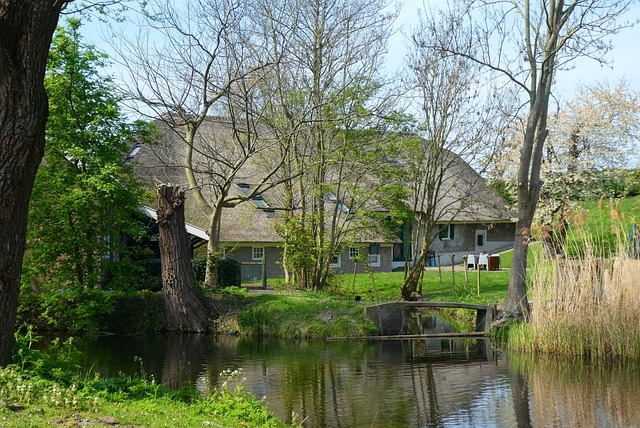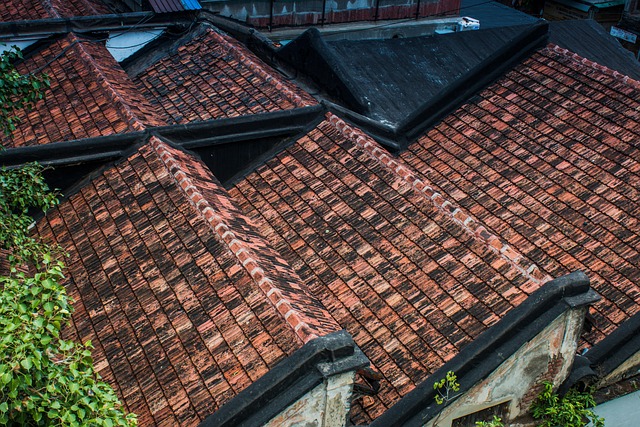Built-up roofing systems are a popular and effective choice for flat commercial buildings due to their multi-ply design. The base includes a flexible bitumen membrane for waterproofing, reinforced with gravel or multi-ply layers for strength. This durable system protects against water intrusion, punctures, and offers easy maintenance, making it a reliable and cost-effective option for commercial structures, with added environmental sustainability benefits.
Built-up roofing systems, a prevalent choice for flat commercial roofs, offer exceptional durability and protection. This comprehensive guide delves into the intricate layers of these systems, exploring the materials, construction techniques, and numerous benefits they provide. From enhancing structural integrity to longevity, we uncover the secrets behind their success. Additionally, we address maintenance, challenges, and environmental considerations, offering valuable insights for informed decision-making in the world of built-up roofing.
- Understanding Built-Up Roofing Layers
- Materials and Construction Techniques
- Advantages for Commercial Buildings
- Maintenance and Longevity Considerations
- Common Challenges and Solutions
- Environmental Impact and Sustainability
Understanding Built-Up Roofing Layers

Built-up roofing systems are a common sight on flat commercial buildings, offering both durability and protection. These systems are created through successive layers of materials, building up a robust barrier against the elements. The foundation lies in a layer of bitumen roofing, a flexible and waterproof membrane that forms the base. On top of this, a series of gravel roof or multi-ply roof layers are added, each contributing to the system’s strength and longevity. This method creates a strong, reliable roof that can withstand various environmental conditions, making it a preferred choice for commercial structures.
Each layer plays a specific role in protecting the building below. The bitumen acts as a barrier against water intrusion, while the gravel or multi-ply layers provide additional protection against punctures and offer a stable surface for future maintenance or repairs. This multi-layered design is not just functional but also allows for easy installation and modifications over time, ensuring that commercial buildings remain secure and weather-resistant.
Materials and Construction Techniques

Built-up roofing systems are a prevalent choice for flat commercial buildings due to their durability and cost-effectiveness. These systems are comprised of multiple layers, typically starting with a base sheet followed by successive layers of bitumen roofing and reinforcement. The primary material used is asphalt or bitumen, which provides the essential water resistance. Each layer is carefully laid and secured with gravel roof or multi-ply membranes to ensure structural integrity.
The construction process involves precise techniques to create a robust barrier. Skilled workers meticulously apply hot bitumen over the substrate, adhering it to the surface using specialized equipment. Reinforcements like fleece or fabric are incorporated to enhance tear resistance. This multi-ply approach not only offers superior protection against weather elements but also provides excellent longevity for the roofing system, making it a preferred choice for commercial properties.
Advantages for Commercial Buildings

Built-up roofing systems offer numerous advantages for commercial buildings. These multi-ply roofs are designed to withstand heavy loads and provide superior durability, making them ideal for flat roofs that often require extra reinforcement. The process involves layering bitumen roofing and reinforcing materials, such as gravel or a polyester mat, creating a robust and protective barrier against environmental elements.
This type of roofing is highly versatile and can be customized to meet specific structural requirements. The addition of a gravel roof or a strong multi-ply layer enhances the system’s performance, ensuring long-term protection for the building below. Built-up roofs are also known for their cost-effectiveness, providing an efficient solution for commercial property owners seeking reliable and sustainable roofing options.
Maintenance and Longevity Considerations

Maintaining a multi-layered built-up roofing system, often consisting of several plies of bitumen and reinforced with gravel or other materials, is crucial for ensuring its longevity on commercial buildings. Regular inspections are essential to identify any signs of damage, such as cracks in the membrane, missing or broken gravel, or moisture intrusion. Prompt repair or replacement of damaged components can prevent more severe issues and prolong the roof’s lifespan.
Proper maintenance also involves keeping the surface free from debris and ensuring adequate ventilation beneath the roof. These measures help regulate temperature and pressure differentials, reducing internal stress on the multi-ply roof structure. By adhering to these practices, building owners can maximize the performance of their built-up roofing systems, which are known for their durability and ability to withstand harsh weather conditions.
Common Challenges and Solutions

The construction of multi-layered built-up roofing systems on flat commercial buildings presents several challenges. One major concern is ensuring water tightness, as these structures are designed to withstand extreme weather conditions while maintaining integrity. A common solution involves utilizing specialized membranes and bitumen roofing, creating a robust barrier against leaks. This meticulous layering approach, often involving multiple plies of materials like asphalt felts and fleece backings, reinforces the roof’s strength and flexibility.
Another challenge is managing weight, especially when incorporating additional protective layers and gravel roofs. To address this, modern built-up roofing systems employ lightweight components while maintaining structural stability. Proper ventilation also plays a crucial role in temperature regulation and prolonging the lifespan of these multi-ply roofs. By implementing these solutions, commercial building owners can effectively maintain their properties with durable, long-lasting built-up roofing systems.
Environmental Impact and Sustainability

Built-up roofing systems, often consisting of multiple layers including a bitumen roofing membrane and a gravel roof, offer more than just protection for flat commercial buildings. Their design also prioritizes environmental sustainability. The multi-ply structure enhances durability, reducing the need for frequent replacements, which in turn minimizes construction waste. Furthermore, these systems can be easily repaired, extending their lifespan and further mitigating environmental impact.
The use of bitumen roofing, a common component in built-up roofs, is also significant from an environmental perspective. Bitumen is derived from natural deposits, making it a renewable resource. Additionally, when properly installed, these roofs provide excellent insulation, contributing to energy efficiency in buildings. This not only reduces the carbon footprint but also lowers operating costs for building owners, making them an eco-friendly and economically viable choice for commercial structures.
